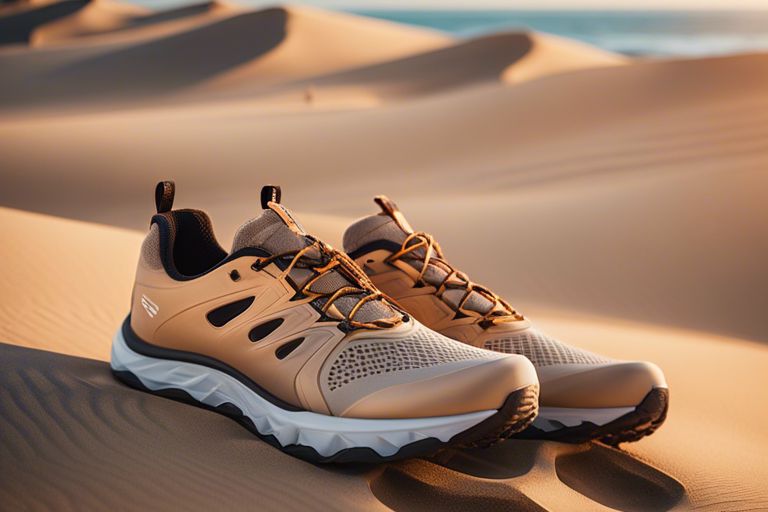Running on sandy terrain can be a challenging yet rewarding experience for fitness enthusiasts. To tackle this unique environment, having the right jogging gear is vital for a successful workout. From footwear that provides stability and traction to moisture-wicking clothing that keeps you comfortable, every piece of gear plays a crucial role. In this blog post, we will explore the best jogging gear specifically designed to enhance your performance on sandy terrain. Whether you’re a beginner or a seasoned runner, investing in the right gear can make all the difference in your sandy terrain jogging experience.
Key Takeaways:
- Choose the right shoes: Opt for trail running shoes with a sturdy sole and good grip to navigate sandy terrains with ease.
- Wear moisture-wicking clothing: Clothing that wicks away sweat will keep you dry and comfortable during your jog on sandy terrain.
- Protect your eyes: Consider wearing sunglasses to shield your eyes from sand particles and UV rays while running.
- Use gaiters: Gaiters can prevent sand from getting into your shoes and socks, keeping your feet sand-free and comfortable.
- Stay hydrated: Bring a water bottle or hydration pack to stay hydrated, especially when jogging in sandy areas which can be more demanding on your body.
Essential Gear for Sandy Terrain Jogging
Choosing the Right Footwear
When jogging in sandy terrain, having the correct footwear is crucial to ensure a comfortable and efficient run. Opt for shoes with a closed mesh upper to prevent sand from entering, and a durable outsole with good traction to navigate through the soft and shifting surfaces. Consider shoes with extra cushioning to absorb impact as sandy terrains can be more demanding on your joints.
Apparel Considerations for Sandy Environments
When preparing for a jog in sandy environments, it is important to choose lightweight and breathable clothing to combat the heat and maintain comfort. Opt for moisture-wicking materials to keep sweat at bay and prevent chafing. Consider wearing gaiters to protect your legs from sand and debris, and sunglasses to shield your eyes from the sun and sand particles.
Protective Accessories and Equipment
Eye Protection
When jogging on sandy terrain, it is vital to protect your eyes from sand particles and harsh sunlight. Invest in a pair of wrap-around sunglasses with UV protection to shield your eyes and ensure clear vision throughout your run. Consider opting for polarised lenses to reduce glare reflected from the sandy surface, providing you with added comfort and safety.
Skin Defense Strategies
Protecting your skin while jogging on sandy terrain is crucial to avoid irritation and sun damage. Use a sweat-resistant and high SPF sunscreen to create a protective barrier against harmful UV rays. Additionally, wearing moisture-wicking clothing can help prevent chafing and rashes caused by abrasive sand particles rubbing against your skin.
It is also recommended to apply sunscreen at least 15 minutes before heading out for your jog and reapply every two hours to maintain its effectiveness, especially if you are sweating profusely. Furthermore, wear a wide-brimmed hat to shield your face and neck from direct sunlight, and consider using a lip balm with SPF to protect your lips from getting dry and cracked. Implementing these skin defence strategies will ensure a comfortable and safe jogging experience on sandy terrain.
Navigational and Safety Tools
GPS Devices and Apps for Route Tracking
When jogging in sandy terrain, having a reliable GPS device or app for route tracking is vital. These tools can help you navigate unfamiliar areas, track your progress, and ensure you can always find your way back to your starting point. Look for devices with long battery life and durable designs that can withstand the elements.
Safety Gear for Remote or Desert Beach Runs
For remote or desert beach runs, safety gear is crucial to ensure your well-being in potentially challenging environments. Items such as a whistle, emergency blanket, and first aid kit can provide necessary assistance in case of emergencies. Additionally, wearing a high-visibility vest or clothing can help you stand out to others in remote areas.
When running in remote or desert beach settings, it’s important to consider potential hazards such as extreme weather conditions, wildlife encounters, or getting lost. Having the right safety gear and being prepared for any situation can make all the difference in ensuring a safe and enjoyable jogging experience.
Maintenance and Care for Your Gear
Cleaning and Storage Tips for Sand-Affected Gear
When jogging on sandy terrain, it’s imperative to take special care of your gear to ensure its longevity and performance. Here are some cleaning and storage tips for sand-affected gear:
- After every run, shake off any excess sand from your shoes, clothing, and accessories.
- Use a gentle brush to remove any stubborn sand particles without damaging the fabric.
- Always let your gear thoroughly air-dry before storing it to prevent mould and mildew growth.
This will help maintain the quality and durability of your jogging gear in sandy conditions. Keep in mind, prevention is key when it comes to preserving your equipment.
Longevity Tips for Jogging Equipment
To extend the lifespan of your jogging equipment, follow these longevity tips:
- Regularly check and replace worn-out parts of your gear, such as shoe soles or elastic bands, to avoid injuries and ensure optimal performance.
Assume that with proper maintenance and timely replacements, your jogging equipment can last for many more runs to come. Invest in quality gear to enjoy a smoother and safer jogging experience.
Training and Conditioning
Exercises to Prepare for Sandy Terrain
When preparing to jog on sandy terrain, it is crucial to incorporate specific exercises into your training routine. Focus on strengthening muscles that are imperative for stability and endurance, such as the calves, quadriceps, hamstrings, and glutes. Incorporate exercises like calf raises, lunges, squats, and plyometric jumps to improve your strength and agility for running on sand.
Adapting Your Jogging Technique for Sand
Adapting your jogging technique for sand is vital to avoid injury and improve performance. When running on sandy terrain, shorten your stride and lift your knees higher to prevent sinking into the sand. Focus on landing mid-foot instead of heel-striking to maintain balance and momentum. Keep a steady pace and engage your core muscles to stabilise your body as you navigate through the challenging terrain.
Running on sand requires a different approach than running on solid ground. It is imperative to adjust your technique to accommodate the softer surface and minimise the risk of injuries. By focusing on your form and incorporating specific exercises into your training regimen, you can enhance your performance and adapt effectively to sandy terrain.
The Best Jogging Gear for Sandy Terrain
When venturing out for a jog in sandy terrain, it is crucial to equip yourself with the right gear to ensure a comfortable and efficient workout. Opt for running shoes with a sturdy outsole and good traction to navigate the sandy terrain smoothly. Wearing moisture-wicking and quick-drying clothing will keep you comfortable as you jog through the sandy terrain. Additionally, consider using gaiters to prevent sand from entering your shoes and socks, making your run more enjoyable. With the right gear, you can conquer sandy terrain and enjoy a fulfilling jogging experience.
FAQ
Q: What are the key features to look for in the best jogging gear for sandy terrain?
A: The key features to look for in the best jogging gear for sandy terrain are breathable and moisture-wicking fabrics, durable and sturdy outsoles with good traction, and secure closures to prevent sand from entering the shoes or clothing.
Q: How important is proper foot support in jogging gear for sandy terrain?
A: Proper foot support is crucial in jogging gear for sandy terrain as it helps prevent injuries such as sprains and strains, provides stability on uneven surfaces, and reduces fatigue during long runs.
Q: What type of clothing is best suited for jogging on sandy terrain?
A: The best clothing for jogging on sandy terrain is lightweight, loose-fitting, and made from moisture-wicking materials to keep you cool and dry. It is also advisable to wear long sleeves and trousers to protect your skin from the sun and sand.
Q: How can I prevent chafing while jogging on sandy terrain?
A: To prevent chafing while jogging on sandy terrain, it is important to wear moisture-wicking clothing that reduces friction, apply anti-chafing balms or powders to problem areas, and ensure that your clothing fits properly to avoid rubbing against your skin.
Q: Are there any specific accessories that can enhance my jogging experience on sandy terrain?
A: Yes, specific accessories such as running gaiters to keep sand out of your shoes, a hydration pack to stay hydrated during long runs, and a hat or sunglasses to protect you from the sun and sand can enhance your jogging experience on sandy terrain.






